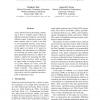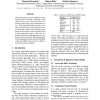ACL
2007
14 years 1 months ago
2007
A key question facing the parsing community is how to compare parsers which use different grammar formalisms and produce different output. Evaluating a parser on the same resource...
ACL
2008
14 years 1 months ago
2008
A well-recognized limitation of research on supervised sentence compression is the dearth of available training data. We propose a new and bountiful resource for such training dat...
ACL
2007
14 years 1 months ago
2007
In this paper, we propose forest-to-string rules to enhance the expressive power of tree-to-string translation models. A forestto-string rule is capable of capturing nonsyntactic ...
ACL
2008
14 years 1 months ago
2008
In this paper we present research in which we apply (i) the kind of intrinsic evaluation metrics that are characteristic of current comparative HLT evaluation, and (ii) extrinsic,...
ACL
2007
14 years 1 months ago
2007
In this paper, we propose a novel discriminative language model, which can be applied quite generally. Compared to the well known N-gram language models, discriminative language m...
ACL
2008
14 years 1 months ago
2008
This paper proposes a novel method to extract named entities including unfamiliar words which do not occur or occur few times in a training corpus using a large unannotated corpus...
ACL
2007
14 years 1 months ago
2007
Non-verbal modalities such as gesture can improve processing of spontaneous spoken language. For example, similar hand gestures tend to predict semantic similarity, so features th...
ACL
2008
14 years 1 months ago
2008
Word and n-gram posterior probabilities estimated on N-best hypotheses have been used to improve the performance of statistical machine translation (SMT) in a rescoring framework....
ACL
2008
14 years 1 months ago
2008
We present a novel fine-grained semantic representation of text and an approach to constructing it. This representation is largely extractable by today's technologies and fac...
ACL
2008
14 years 1 months ago
2008
This paper describes a novel event-matching strategy using features obtained from the transitive closure of dependency relations. The method yields a model capable of matching eve...



